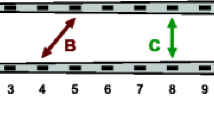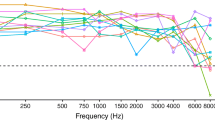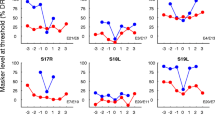Abstract
Interaural timing cues are important for sound source localization and for binaural unmasking of speech that is spatially separated from interfering sounds. Users of a cochlear implant (CI) with residual hearing in the non-implanted ear (bimodal listeners) can only make very limited use of interaural timing cues with their clinical devices. Previous studies showed that bimodal listeners can be sensitive to interaural time differences (ITDs) for simple single- and three-channel stimuli. The modulation enhancement strategy (MEnS) was developed to improve the ITD perception of bimodal listeners. It enhances temporal modulations on all stimulated electrodes, synchronously with modulations in the acoustic signal presented to the non-implanted ear, based on measurement of the amplitude peaks occurring at the rate of the fundamental frequency in voiced phonemes. In the first experiment, ITD detection thresholds were measured using the method of constant stimuli for five bimodal listeners for an artificial vowel, processed with either the advanced combination encoder (ACE) strategy or with MEnS. With MEnS, detection thresholds were significantly lower, and for four subjects well within the physically relevant range. In the second experiment, the extent of lateralization was measured in three subjects with both strategies, and ITD sensitivity was determined using an adaptive procedure. All subjects could lateralize sounds based on ITD and sensitivity was significantly better with MEnS than with ACE. The current results indicate that ITD cues can be provided to bimodal listeners with modified sound processing.









Similar content being viewed by others
Abbreviations
- CI:
-
Cochlear implant
- F0:
-
Fundamental frequency
- HA:
-
Hearing aid
- ILD:
-
Interaural level difference
- ITD:
-
Interaural time difference
- JND:
-
Just noticeable difference
- MEnS:
-
Modulation enhancement strategy
- NH:
-
Normal hearing
References
Akeroyd M (2003) Threshold differences for interaural time delays carried by double vowels. J Acoust Soc Am 114(4 Pt 1):2167–2177
Akeroyd M (2006) The psychoacoustics of binaural hearing. Int J Audiol 45(Suppl 1):25–33
Bernstein L, Trahiotis C (2002) Enhancing sensitivity to interaural delays at high frequencies by using “transposed stimuli”. J Acoust Soc Am 112(3 Pt 1):1026–1036
Bernstein L, Trahiotis C (2009) How sensitivity to ongoing interaural temporal disparities is affected by manipulations of temporal features of the envelopes of high-frequency stimuli. J Acoust Soc Am 125(5):3234–3242
Bernstein L, Trahiotis C (2010) Accounting quantitatively for sensitivity to envelope-based interaural temporal disparities at high frequencies. J Acoust Soc Am 128(3):1224–1234
Boersma P, Weenink D (2001) Praat, a system for doing phonetics by computer. Glot Int 5(9/10):341–345
Bronkhorst A (2000) The cocktail party phenomenon: a review of research on speech intelligibility in multiple-talker conditions. Act Acust 86(6):117–128
Buell T, Griffin S, Bernstein L (2008) Listeners’ sensitivity to “onset/offset” and “ongoing” interaural delays in high-frequency, sinusoidally amplitude-modulated tones. J Acoust Soc Am 123:279
Ching T, van Wanrooy E, Dillon H (2007) Binaural-bimodal fitting or bilateral implantation for managing severe to profound deafness: a review. Trends Amplif 11(3):161–192
Colburn H, Shinn-Cunningham B, Kidd G, Durlach N (2006) The perceptual consequences of binaural hearing. Int J Audiol 45(Suppl 1):34–44
Domnitz R (1973) The interaural time JND as a simultaneous function of interaural time and interaural amplitude. J Acoust Soc Am 53(6):1549–1552
Ewert S, Dietz M, Klein-Hennig M, Hohmann V (2009) Advances in auditory physiology, psychophysics and models; the role of envelope wave form, adaptation, and attacks in binaural perception. Springer, New York
Francart T, McDermott H (2012a) Development of a loudness normalisation strategy for combined cochlear implant and acoustic stimulation. Hear Res 294(1–2):114–124
Francart T, McDermott H (2012b) Speech perception and localisation with SCORE bimodal: a loudness normalisation strategy for combined cochlear implant and hearing aid stimulation. Plos One 7(10)
Francart T, van Wieringen A, Wouters J (2008) APEX 3: a multi-purpose test platform for auditory psychophysical experiments. J Neurosci Methods 172(2):283–293
Francart T, Brokx J, Wouters J (2009) Sensitivity to interaural time differences with combined cochlear implant and acoustic stimulation. J Assoc Res Otolaryngol 10(1):131–141
Francart T, Lenssen A, Wouters J (2011) Sensitivity of bimodal listeners to interaural time differences with modulated single- and multiple-channel stimuli. Audiol Neurootol 16(2):82–92
Francart T, Lenssen A, Wouters J (2012) The effect of interaural differences in envelope shape on the perceived location of sounds. J Acoust Soc Am 132(2):611–614
Freyman RL, Zurek PM, Balakrishnan U, Chiang YC (1997) Onset dominance in lateralization. J Acoust Soc Am 101(3):1649–1659
Grantham D, Ashmead D, Ricketts T, Haynes D, Labadie R (2008) Interaural time and level difference thresholds for acoustically presented signals in post-lingually deafened adults fitted with bilateral cochlear implants using cis processing. Ear Hear 29(1):33–44
Green T, Faulkner A, Rosen S (2004) Enhancing temporal cues to voice pitch in continuous interleaved sampling cochlear implants. J Acoust Soc Am 116(4 Pt 1):2298–2310
Henning G (1974) Detectability of interaural delay in high-frequency complex waveforms. J Acoust Soc Am 55(1):84–90
ISO 389-2 (1994) ISO 389-2 reference zero for the calibration of audiometric equipment—part 2: reference equivalent threshold sound pressure levels for pure tones and insert earphones
Klatt D (1980) Software for a cascade/parallel formant synthesizer. J Acoust Soc Am 67(3):971–995
Kunov H, Abel S (1981) Effects of rise/decay time on the lateralization of interaurally delayed 1-khz tones. J Acoust Soc Am 69(3):769–773
Laback B, Pok S, Baumgartner W, Deutsch W, Schmid K (2004) Sensitivity to interaural level and envelope time differences of two bilateral cochlear implant listeners using clinical sound processors. Ear Hear 25(5):488–500
Laback B, Majdak P, Baumgartner W (2007) Lateralization discrimination of interaural time delays in four-pulse sequences in electric and acoustic hearing. J Acoust Soc Am 121(4):2182–2191
Laback B, Zimmerman I, Majdak P, Baumgartner W, Pok S (2011) Effects of envelope shape on interaural envelope delay sensitivity in acoustic and electric hearing. J Acoust Soc Am 130(3):1515–1529
Laneau J, Wouters J, Moonen M (2006) Improved music perception with explicit pitch coding in cochlear implants. Audiol Neurotol 11(1):38–52
Lawson D, Wilson B, Zerbi M, van den Honert C, Finley C, Farmer J Jr, McElveen J Jr, Roush P (1998) Bilateral cochlear implants controlled by a single speech processor. Am J Otol 19(6):758–761
Lenssen A, Francart T, Brokx J, Wouters J (2011) Bimodal listeners are not sensitive to interaural time differences in unmodulated low-frequency stimuli. J Acoust Soc Am 129(6):3457–3460
Litovsky R, Jones G, Agrawal S, van Hoesel R (2010) Effect of age at onset of deafness on binaural sensitivity in electric hearing in humans. J Acoust Soc Am 127(1):400–414
Litovsky R, Goupell M, Godar S, Grieco-Calub T, Garadat S, Agrawal S, van Hoesel R (2012) Studies on bilateral cochlear implants at the University of Wisconsin’s Binaural Hearing and Speech Laboratory. J Am Acad Audiol 23(1):476–494
Long C, Eddington D, Colburn H, Rabinowitz W (2003) Binaural sensitivity as a function of interaural electrode position with a bilateral cochlear implant user. J Acoust Soc Am 114(3):1565–1574
Majdak P, Laback B, Baumgartner W (2006) Effects of interaural time differences in fine structure and envelope on lateral discrimination in electric hearing. J Acoust Soc Am 120(4):2190–2201
McDermott H, McKay C, Vandali A (1992) A new portable sound processor for the University of Melbourne/nucleus limited multielectrode cochlear implant. J Acoust Soc Am 91(6):3367–3371
Milczynski M, Wouters J, van Wieringen A (2009) Improved fundamental frequency coding in cochlear implant signal processing. J Acoust Soc Am 125(4):2260–2271
Milczynski M, Chang JE, Wouters J, van Wieringen A (2012) Perception of Mandarin Chinese with cochlear implants using enhanced temporal pitch cues. Hear Res 285(1–2):1–12
Sayers B (1964) Acoustic-image lateralization judgments with binaural tones. J Acoust Soc Am 36(5):923–926
Senn P, Kompis M, Vischer M, Haeusler R (2005) Minimum audible angle, just noticeable interaural differences and speech intelligibility with bilateral cochlear implants using clinical speech processors. Audiol Neurootol 10(6):342–352
Swanson B (2008) Pitch perception with cochlear implants. Ph.D. thesis, The University of Melbourne
van Hoesel R (2004) Exploring the benefits of bilateral cochlear implants. Audiol Neurootol 9(4):234–246
van Hoesel R (2007) Sensitivity to binaural timing in bilateral cochlear implant users. J Acoust Soc Am 121(4):2192–2206
van Hoesel R, Tyler R (2003) Speech perception, localization, and lateralization with bilateral cochlear implants. J Acoust Soc Am 113(3):1617–1630
Vandali AE, van Hoesel RJ (2011) Development of a temporal fundamental frequency coding strategy for cochlear implants. J Acoust Soc Am 129(6):4023–4036
Vandali A, Whitford L, Plant K, Clark G (2000) Speech perception as a function of electrical stimulation rate: using the Nucleus 24 cochlear implant system. Ear Hear 21(6):608–624
Vandali A, Sucher C, Tsang D, McKay C, Chew J, McDermott H (2005) Pitch ranking ability of cochlear implant recipients: a comparison of sound-processing strategies. J Acoust Soc Am 117(5):3126–3138
Wichmann F, Hill N (2001) The psychometric function: II. Bootstrap-based confidence intervals and sampling. Percept Psychophys 63(8):1314–1329
Acknowledgments
We are grateful to our test subjects, who inexhaustibly and enthusiastically participated in numerous test sessions, listening to the same sounds over and over again. We thank Prof. Hugh McDermott for his useful comments on an earlier version of the manuscript. This research was supported by IWT-Vlaanderen and Cochlear, project 110722. Tom Francart was sponsored by a Post Doctoral Mandate (BOF) from the KU Leuven, a Post Doctoral Fellowship of the Fund for Scientific Research of the Flemish Government and a Marie Curie International Outgoing Fellowship of the European Commission, grant agreement number PIOF-GA-2009-252730. Anneke Lenssen was sponsored by the EU-ITN project AUDIS, grant agreement number PITN-GA-2008-214699. We thank the staff of the audiology department of the hospital of Maastricht, the audiology center of Eindhoven, and the hospital of Leuven for their kind cooperation and flexibility.
Author information
Authors and Affiliations
Corresponding author
Additional information
Tom Francart and Anneke Lenssen contributed equally to this study and should be regarded as joint first authors
Rights and permissions
About this article
Cite this article
Francart, T., Lenssen, A. & Wouters, J. Modulation Enhancement in the Electrical Signal Improves Perception of Interaural Time Differences with Bimodal Stimulation. JARO 15, 633–647 (2014). https://doi.org/10.1007/s10162-014-0457-9
Received:
Accepted:
Published:
Issue Date:
DOI: https://doi.org/10.1007/s10162-014-0457-9




